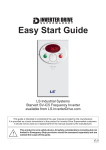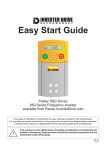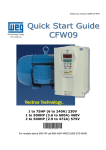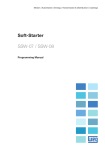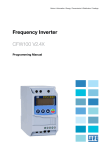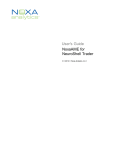Download WEG CFW-08 - Inverter Drive Supermarket
Transcript
Easy Start Guide VECTOR INVERTER 1 2 3 4 5 6 7 8 9 10 11 12 WEG CFW-08 Frequency Inverter available from WEG.InverterDrive.com This guide is intended to compliment the user manual provided by the manufacturer. It is provided as a basic introduction to the product for Inverter Drive Supermarket customers. It should not be used as a replacement for the manual issued by the manufacturer. This product is not a safety device. All safety considerations including but not limited to Emergency Stop provision should be assessed separately and are outside the scope of this guide. Issue 2 20140223 Easy Start Guide WEG CFW-08 Series Inverter Contents Page 1 Contents Page 2 Power and Motor Connections (Single Phase) Page 3 Power and Motor Connections (Three Phase) Page 4 Motor Connections - Star and Delta Page 5 Parameters - Overview Parameters to set before use Page 6 How to set a Parameter value Page 7 How to Operate the Inverter from the keypad Page 8 How to switch from Local (keypad) control to Remote (terminal) control and back Page 9 How to enable Sensorless Vector Mode Page 10 How to connect and configure a Potentiometer for remote speed control Page 11 How to connect and configure a Run Forward or Run Reverse switch Page 12 How to connect and configure a Run/Stop switch with Forward/Reverse selection Page 13 How to configure “3-Wire” control with Run/Stop pushbuttons and Forward/Reverse selection Page 14 Brake Resistor Connection Page 15 How to Reset the Inverter to Factory Defaults This guide has been produced by The Inverter Drive Supermarket Ltd. All content, including but not limited to graphics, text and procedures copyright © The Inverter Drive Supermarket and must not be reproduced or altered without prior written permission. Page 1 Easy Start Guide WEG CFW-08 Series Inverter 1. Power and Motor Connections (Single Phase) Before commencing, confirm that the Inverter and all cables are completely isolated from the power supply, have been isolated for at least 5 minutes and that the motor is not turning. VECTOR INVERTER 1 2 3 4 5 6 7 8 9 10 11 12 L/L1 N/L2 L3 U V W Phase Phase Phase Earth Live Neutral Earth Power Motor Notes: Important: The illustration above is based on the frame size 2 rating (1.5kW). The terminal layout for other sizes and the “Wash” model is similar. Use screened SY cable between the Inverter and Motor to minimise electromagnetic interference. The order of the three phases determines the direction the motor turns. Ensure the motor cable screen is earthed at the motor end. This guide has been produced by The Inverter Drive Supermarket Ltd. All content, including but not limited to graphics, text and procedures copyright © The Inverter Drive Supermarket and must not be reproduced or altered without prior written permission. Page 2 Easy Start Guide WEG CFW-08 Series Inverter 2. Power and Motor Connections (Three Phase) Before commencing, confirm that the Inverter and all cables are completely isolated from the power supply, have been isolated for at least 5 minutes and that the motor is not turning. VECTOR INVERTER 1 2 3 4 5 6 7 8 9 10 11 12 L/L1 N/L2 L3 U V W Phase Phase Phase Earth Power Phase Phase Phase Earth Motor Notes: Important: The illustration above is based on the frame size 2 rating (1.5kW). The terminal layout for other sizes and the “Wash” model is similar. The order of the three motor phases determines the direction the motor turns. The order of the three power phases is unimportant. Use screened SY cable between the Inverter and Motor to minimise electromagnetic interference. Ensure the motor cable screen is earthed at the motor end. This guide has been produced by The Inverter Drive Supermarket Ltd. All content, including but not limited to graphics, text and procedures copyright © The Inverter Drive Supermarket and must not be reproduced or altered without prior written permission. Page 3 Easy Start Guide WEG CFW-08 Series Inverter 3. Motor Connections - Star and Delta Dual voltage induction motors typically include terminal boxes with six points. The points can be connected together with links in one of two ways to suit one of the two rated voltages. The two ways of connecting the links are shown below. These are known as “Star” (the higher voltage) or “Delta” (the lower voltage). The selection of Star or Delta is not optional and must match the supply voltage. Dual voltage motor nameplates include symbols to represent voltage and full load current in each configuration. Delta is represented by a triangle and star by an inverted Y (Wye). 3.1 Motor connected in STAR (or Wye): Link STAR Earth For safety purposes, Star (shown opposite) is the default configuration for new motors and is sometimes known as “two at one side”. Only two links are required for Star. Double-up the links if changing from Delta to allow the motor to be changed back in future. Phase The order of the three phases determines the direction the motor turns. Phase Phase Note that the cable screen and earth are connected together at the earth terminal. Screen 3.2 Motor connected in DELTA: Link DELTA Earth Phase The Delta link configuration is shown in the illustration opposite and is sometimes referred to as “three-a-breast”. The order of the three phases determines the direction the motor turns. Note that the cable screen and earth are connected together at the earth terminal. Phase Phase Screen This guide has been produced by The Inverter Drive Supermarket Ltd. All content, including but not limited to graphics, text and procedures copyright © The Inverter Drive Supermarket and must not be reproduced or altered without prior written permission. Page 4 Easy Start Guide WEG CFW-08 Series Inverter 4. Parameters - overview The Inverter contains a number of settings which can be changed to tailor it for use with a wide range of motor ratings and applications. These settings are known as parameters. Parameters are typically referred to by code or number (eg. P401 = Rated Motor Current) with a description available in the manual. The parameters contain critical information essential to the correct operation of the Inverter. Therefore, they should at least be checked by the installer before the Inverter is operated for the first time. The parameters listed in section 5 are intended to provide a starting point to allow for basic operation of the CFW-08 Inverter. 5. Parameters to set before use Set the following parameters to allow the CFW-08 to control a motor with Run, Stop and Speed Control from the keypad. If any of the parameters have been changed previously, follow the procedure in section 15 to reset the Inverter to Factory Defaults. See section 6 to learn how to set a parameter value. 5.1 Parameters to check and values to set Parameter Description How to set P000 Parameter Access Set to 5 to allow parameters to be changed P100 Acceleration Time (seconds) Default is 5.0 Increase or decrease if required. P101 Deceleration Time (seconds) Default is 10.0 Increase or decrease if required. P133 Minimum Frequency (Hz) Default is 3.00. Set to 5.00 for most applications. P134 Maximum Frequency (Hz) Default is 55.00 or 66.00. Set to 50.00 for most applications. P202 Control Mode Default is 0 (linear). Can be set to 1 (quadratic) if the motor is driving a Fan or Pump. P399 Rated Motor Efficiency Set to match motor if known - eg. 71.00 (%) P400 Rated Motor Voltage Set to match motor nameplate - eg. 230 P401 Rated Motor Current Set to match motor nameplate - eg. 3.34 (Amps) P402 Rated Motor Speed Set to match motor nameplate - eg. 1430 (rpm, look for min -1) P403 Rated Motor Frequency Set to match motor nameplate - eg. 50.00 (Hz) P404 Rated Motor Power Refer to P404 table in manual and set to match motor nameplate - eg. 6 (for 1.5 kW) P407 Rated Motor Power Factor Set to match motor if known - eg. 0.74 (look for cos φ) Note: Although some parameters are only used in Sensorless Vector Mode (see Section 9), we recommend that all the above are set. This guide has been produced by The Inverter Drive Supermarket Ltd. All content, including but not limited to graphics, text and procedures copyright © The Inverter Drive Supermarket and must not be reproduced or altered without prior written permission. Page 5 Easy Start Guide WEG CFW-08 Series Inverter 6. How to set a Parameter value 6.1 Find the Parameter List. This example demonstrates the steps required to set parameter P401 which is Rated Motor Current. With the motor stopped, press the “PROG” button to access the parameter list. The display will show the letter “P” followed by a three digit number. Typically, this is P000 as shown in the illustration opposite. 6.2 Find the Parameter to change Use the up and down keys to find the required parameter. In this example, P401. Press the “PROG” key to select the parameter value. 6.3 Set the Parameter Value Use the up and down keys to set the parameter value as required. In this example, the motor nameplate shows a rated current of 6.47A so the value is set accordingly. Note: If you are unable to change the value, ensure that parameter P000 is set to 5. Some parameters may be read-only so cannot be changed even when P000 is set to 5. 6.4 Finished. Press “PROG” to save changes. The display will return to the current parameter. This guide has been produced by The Inverter Drive Supermarket Ltd. All content, including but not limited to graphics, text and procedures copyright © The Inverter Drive Supermarket and must not be reproduced or altered without prior written permission. Page 6 Easy Start Guide WEG CFW-08 Series Inverter 7. How to operate the Inverter from the keypad 7.1 Ensure the Inverter is in “Local” control mode. Press the “Loc/Rem” button repeatedly until the green indicator lamp next to the “Loc/Rem” button is illuminated. See section 8 for further information on Local and Remote modes. 7.2 Set Parameter P121 to the required speed Set parameter P121 (Keypad Reference) to the desired speed. In this example, 25.00Hz is half the rated speed for a standard 50Hz Induction Motor. Leave the display showing the speed in Hz. See section 6 to learn how to set a parameter value. 7.3 Start the motor and change direction Press the green button to start the motor. The motor will accelerate to the required speed in the time specified by parameter P100. Use the up and down keys to change the speed as required. Pressing the direction button (see illustration opposite) will first decelerate the motor to zero speed before accelerating up to the current speed in the opposite direction. Parameters P100 and P101 control the acceleration and deceleration time in seconds. The lamps on the left indicate direction; green = forward, red = reverse. 7.4 Stop the motor Press the red button to stop the motor. The motor will decelerate to a stop in the time specified by parameter P101. Once stopped, the display will show “rdy” (ready). This guide has been produced by The Inverter Drive Supermarket Ltd. All content, including but not limited to graphics, text and procedures copyright © The Inverter Drive Supermarket and must not be reproduced or altered without prior written permission. Page 7 Easy Start Guide WEG CFW-08 Series Inverter 8. How to switch from Local (keypad) control to Remote (terminal) control and back 8.1 Local (keypad) control When the green indicator lamp next to the “Loc/Rem” button is illuminated, the Inverter is in “Local” mode. When in “Local” mode, the motor can be controlled using the integrated keypad. The defaults are:Start/Stop, Speed Up/Down, Forward/Reverse rotation, Jog 8.2 Remote (terminal) control When the red indicator lamp next to the “Loc/Rem” button is illuminated, the Inverter is in “Remote” mode. When in “Remote” mode, the motor can be controlled using the terminal block. 8.3 Toggle between Local and Remote control Press the “Loc/Rem” button again to toggle from Local to Remote or from Remote to Local. This guide has been produced by The Inverter Drive Supermarket Ltd. All content, including but not limited to graphics, text and procedures copyright © The Inverter Drive Supermarket and must not be reproduced or altered without prior written permission. Page 8 Easy Start Guide WEG CFW-08 Series Inverter 9. How to enable Sensorless Vector Mode The standard operating mode of the CFW-08 Inverter is VxF. This is the simplest form of operation and controls Volts and Frequency to vary the speed of a standard Induction Motor. The CFW-08 can also operate in Sensorless Vector mode. This can improve motor performance without requiring a separate feedback device. In order to improve performance, Sensorless Vector builds a “model” of the motor it is controlling. This is achieved by a “tuning” run during which the Inverter operates for approx. 2 minutes to gather the necessary motor data. Note: Sensorless Vector is not suitable where the motor rating is significantly lower than the Inverter rating or where more than one motor is being controlled. Invoking a “tuning” run in these cases will not be successful and return an E14 error. 9.1 Parameters to check and values to set Parameter Description How to set P000 Parameter Access Set to 5 to allow parameters to be changed P202 Control Mode Default is 0 (linear). Set to 2 to enable Sensorless Vector Control. P408 Run Self-Tuning Default is 0. Ensure motor is off-load before changing to 1 to begin self-tuning. The display will flash “auto” whilst the CFW-08 performs it’s tuning run. This guide has been produced by The Inverter Drive Supermarket Ltd. All content, including but not limited to graphics, text and procedures copyright © The Inverter Drive Supermarket and must not be reproduced or altered without prior written permission. Page 9 Easy Start Guide WEG CFW-08 Series Inverter 10. How to connect and configure a Potentiometer for remote speed control If the up/down buttons on the keypad are unsuitable for the application, a remote Potentiometer can be used instead. This provides the benefit of allowing motor speed to be controlled from a more convenient location such as a cabinet door (if the CFW-08 is cabinet-mounted) or on the machine itself. A Potentiometer of 10kOhm rating should be used. The number of turns depends on the application but both single turn and ten turn Potentiometers are available from The Inverter Drive Supermarket at InverterDrive.com. Ensure the Inverter is in “Remote” mode before continuing. 10.1 Parameters to change for remote Potentiometer speed control Parameter Description How to set P000 Parameter Access Set to 5 to allow parameters to be changed P221 Frequency Local Reference Set to 0 to use the keypad up/down keys or 1 to enable the Potentiometer in Local mode P222 Frequency Remote Reference Set to 1 to enable the Potentiometer via AI1 in Remote mode P133 Minimum Frequency Set to 5 for Potentiometer lowest speed of 5Hz (or set as required) P134 Maxmum Frequency Set to 50 for Potentiometer highest speed of 50Hz (or set as required) P233 Analog Input Dead Zone Set to 0 to set 0V to min speed and 10V to max speed so full Potentiometer rotation is used P235 Analog Input AI1 Function Set to 0 to enable 0-10V (check S1:3 DIP switch behind keypad is off) COM AI1 +10V 10.2 Connecting the Potentiometer 1 2 3 4 5 6 7 8 9 10 11 12 3 2 A wiring diagram is shown in the illustration opposite. The most important connection at the Potentiometer end is the centre terminal or “wiper”. 1 Screened “SY” Cable Screen to Earth Terminal 1 2 3 The wiper will output a variable voltage between 0 and 10 volts and should be connected to terminal 6 at the Inverter end. It is this voltage which provides the speed signal with 0V being slowest and 10V fastest. Set the Potentiometer at its “half-way” position before running the motor for the first time. If the rotation of the Potentiometer is the opposite to that required (ie. turn anti-clockwise to 10kOhm increase speed instead of clockwise) reverse Potentiometer [Order Code 21302] connections +10V and COM. Use shielded SY cable between Potentiometer and Inverter and ensure that the cable screen is connected to the Inverter earth terminal. This guide has been produced by The Inverter Drive Supermarket Ltd. All content, including but not limited to graphics, text and procedures copyright © The Inverter Drive Supermarket and must not be reproduced or altered without prior written permission. Page 10 Easy Start Guide WEG CFW-08 Series Inverter 11. How to connect and configure a Run Forward or Run Reverse switch The parameters described in Section 5 enable Run/Stop operation via the red and green buttons on the Inverter. This section explains how to enable 2-wire control with Run Forward / Stop / Run Reverse commands via a single selector switch. If this is unsuitable for the application, a remote switch can be used instead. Ensure the Inverter is in “Remote” mode before continuing. 11.1 Parameters to change for remote Run/Stop Parameter Description How to set P000 Parameter Access Set to 5 to allow parameters to be changed P230 Remote Command Selection Set to 1 to use the Inverter terminals (as opposed to keypad) P263 Digital input 1 (T1) function Set to 8 for Forward Run on T1 (ignore E24 error, will clear when P264, P265, P266 are set) P264 Digital input 2 (T2) function Set to 8 for Reverse Run on T2 P265 Digital input 3 (T3) function Set to 10 for reset on T3 (or set to 1, 3, 6, 11, 12, 13 or 15 as required but no other values) P266 Digital input 4 (T4) function Set to 3 for run Jog on T4 (or set to 1, 6, 11, 12, 13, 14 or 15 as required but no other values) DI1 DI2 COM 11.2 Connecting the Switch 1 2 3 4 5 6 7 8 9 10 11 12 1 2 A wiring diagram is shown in the illustration opposite. 3 Terminal 5 (COM) is a common connection for terminals 1-4, 6 and 8 and has no other function. A suitable 3 position NO (Normally Open) switch should be installed between terminals 1 (DI1), 2 (DI2) and 5 (COM). The centre position should remain open circuit. When a connection is made between terminals 1 (DI1) and 5 (COM), the motor will run forward. When terminals 2 (DI2) and 5 (COM) are connected, the motor will run in reverse. 123 R F Switch, 3 Position Normally Open “Run Forward / Stop / Run Reverse” Care should be taken to ensure that terminals 1 (DI1) and 2 (DI2) cannot be connected to 5 (COM) at the same time or to each other. If motor rotation is the opposite to that required, simply swap connections 1 and 2. This guide has been produced by The Inverter Drive Supermarket Ltd. All content, including but not limited to graphics, text and procedures copyright © The Inverter Drive Supermarket and must not be reproduced or altered without prior written permission. Page 11 Easy Start Guide WEG CFW-08 Series Inverter 12. How to connect and configure a Run/Stop switch with Forward/Reverse selection The parameters described in Section 5 enable Run/Stop operation via the red and green buttons on the Inverter. This section explains how to enable 2-wire control with Run/Stop and Forward/Reverse commands via separate selector switches. If this is unsuitable for the application, remote switches can be used instead. Ensure the Inverter is in “Remote” mode before continuing. 12.1 Parameters to change for remote Run/Stop Parameter Description How to set P000 Parameter Access Set to 5 to allow parameters to be changed P230 Remote Command Selection Set to 1 to use the Inverter terminals (as opposed to keypad) P263 Digital input 1 (T1) function Set to 0 for “General Enable” on T1 P264 Digital input 2 (T2) function Set to 0 for Forward/Reverse on T2 P265 Digital input 3 (T3) function Set to 10 for reset on T3 (or set to 1, 3, 6, 11, 12, 13 or 15 as required but no other values) P266 Digital input 4 (T4) function Set to 8 for Start/Stop on T4 DI1 DI2 DI4 COM 12.2 Connecting the Switch 1 2 3 4 5 6 7 8 9 10 11 12 2 3 A wiring diagram is shown in the illustration opposite. 1 Terminal 5 (COM) is a common connection for terminals 1-4, 6 and 8 and has no other function. General Enable Link Two suitable 2 position NO (Normally Open) switches should be installed: One between terminals 4 and 5 (Run/Stop) and the other between terminals 2 and 5 (Forward/Reverse). 21 31 Note that the Forward/Reverse switch only selects the direction of rotation - it will not start or stop the motor. R Switch, 2 Position Normally Open “Forward / Reverse” A “General Enable” link is required between terminals 1 and 5. If this link is removed whilst the motor is running, the motor will coast to a stop (rather than controlled deceleration). Switch, 2 Position Normally Open “Run / Stop” If the application only requires the motor to turn in one direction, the Forward/Reverse switch can be omitted. This guide has been produced by The Inverter Drive Supermarket Ltd. All content, including but not limited to graphics, text and procedures copyright © The Inverter Drive Supermarket and must not be reproduced or altered without prior written permission. Page 12 Easy Start Guide WEG CFW-08 Series Inverter 13. How to configure “3-Wire” control with Run/Stop pushbuttons and Forward/Reverse selection The parameters described in Section 5 enable Run/Stop operation via the red and green buttons on the Inverter. This section explains how to enable 3-wire control with Run and Stop via pushbuttons and Forward/Reverse via a selector switch. If this is unsuitable for the application, remote switches can be used instead. Ensure the Inverter is in “Remote” mode before continuing. 13.1 Parameters to change for remote 3-wire control Parameter Description How to set P000 Parameter Access Set to 5 to allow parameters to be changed P230 Remote Command Selection Set to 1 to use the Inverter terminals (as opposed to keypad) P263 Digital input 1 (T1) function Set to 14 for 3-wire control “Start” on T1 (ignore E24 error, will clear when P264 is set) P264 Digital input 2 (T2) function Set to 14 for 3-wire control “Stop” on T2 P265 Digital input 3 (T3) function Set to 10 for reset on T3 (or set to 1, 3, 6, 11, 12, 13 or 15 as required but no other values) P266 Digital input 4 (T4) function Set to 0 for forward/reverse selection on T4 DI1 DI2 DI4 COM 13.2 Connecting the Switches 1 2 3 4 5 6 7 8 9 10 11 12 2 3 4 A wiring diagram is shown in the illustration opposite. Terminal 5 (COM) is a common connection for terminals 1-4, 6 and 8 and has no other function. 1 For “Run” and “Stop”, two suitable pushbuttons should be installed. The “Run” pushbutton should include a Normally Open contact between terminals 5 (COM) and 1 (DI1) and the “Stop” a Normally Closed contact between terminals 5 (COM) and 2 (DI2). For “Forward/Reverse” a suitable 2 position NO (Normally Open) switch should be installed between terminals 5 (COM) and 4 (DI4). 21 31 41 R Pushbutton Normally Open “Run” A momentary connection between 5 (COM) and 1 (DI1) will start the motor. It will continue to run until the connection between 5 (COM) and 2 (DI2) is broken. Note that the Forward/Reverse switch only selects the direction of rotation - it will not start Pushbutton Switch, 2 Position or stop the motor. If the application only requires the motor to turn in one direction, the Normally Closed Normally Open “Stop” “Forward / Reverse” Forward/Reverse switch can be omitted. This guide has been produced by The Inverter Drive Supermarket Ltd. All content, including but not limited to graphics, text and procedures copyright © The Inverter Drive Supermarket and must not be reproduced or altered without prior written permission. Page 13 Easy Start Guide WEG CFW-08 Series Inverter 14. Brake Resistor Connection Before commencing, confirm that the Inverter and all cables are completely isolated from the power supply, have been isolated for at least 5 minutes and that the motor is not turning. High inertia loads can cause overvoltage trips during deceleration and lead to “E01" error messages. In many cases, the solution is to increase the deceleration time to compensate. A Brake Resistor is first installed to absorb braking energy and dissipate it as heat. The resistor must be correctly sized for both the Inverter and application. However, if the application requires it, dynamic braking can be used to maintain or reduce deceleration times by absorbing the energy generated by such loads. A “brake chopper” within the Inverter detects excessive braking energy and redirects it to the resistor as required. 14.1 Parameters to change for Dynamic Braking Parameter Description How to set P000 Parameter Access Set to 5 to allow parameters to be changed P151 DC Link Voltage Regulation Level Set to 380 for 230V Inverter or 780V for 400V Inverter (default values). 14.2 Connecting the Resistor A wiring diagram is shown in the illustration opposite. Connect the brake resistor to the BR and +UD Terminals on the Inverter. The order of the connections is unimportant. The braking resistor may get hot during operation. Ensure that it is mounted in a suitable position away from other items. VECTOR INVERTER It is important that a resistor of the correct rating is used. Consult the manufacturer’s manual or product listing on InverterDrive.com for further information. 1 2 3 4 5 6 7 8 9 10 11 12 BR +UD +UD BR Heat Resistant Cable This guide has been produced by The Inverter Drive Supermarket Ltd. All content, including but not limited to graphics, text and procedures copyright © The Inverter Drive Supermarket and must not be reproduced or altered without prior written permission. Page 14 Easy Start Guide WEG CFW-08 Series Inverter 15. How to reset the Inverter to Factory Defaults 15.1 Select Parameter P000 With the motor stopped, press the “PROG” button to select parameters. The display will show the letter “P” followed by a three digit number. Use the up and down keys to select P000 if it is not already selected. 15.2 Set Parameter P000 to 5 Press the “PROG” button again to select the parameter value. Use the up and down keys to set this value to 5. Press “PROG” again to save. The display will return to P000. Note: setting P000 to 5 allows other parameters to be changed. 15.3 Select Parameter P204 Use the up and down keys to select P204. Press the “PROG” button to see the current value (typically “0"). 15.4 Set Parameter P204 to 5 Use the up and down keys to change the value to 5. Press “PROG” again to save. The display will flash briefly and change from 5 back to 0. Press “the “PROG” button to return to P000. Note: setting P204 to 5 will reset the Inverter back to factory defaults. This will also reset P000 back to 0. Ensure that you set P000 to 5 before attempting to change any other parameters. This guide has been produced by The Inverter Drive Supermarket Ltd. All content, including but not limited to graphics, text and procedures copyright © The Inverter Drive Supermarket and must not be reproduced or altered without prior written permission. Page 15

















